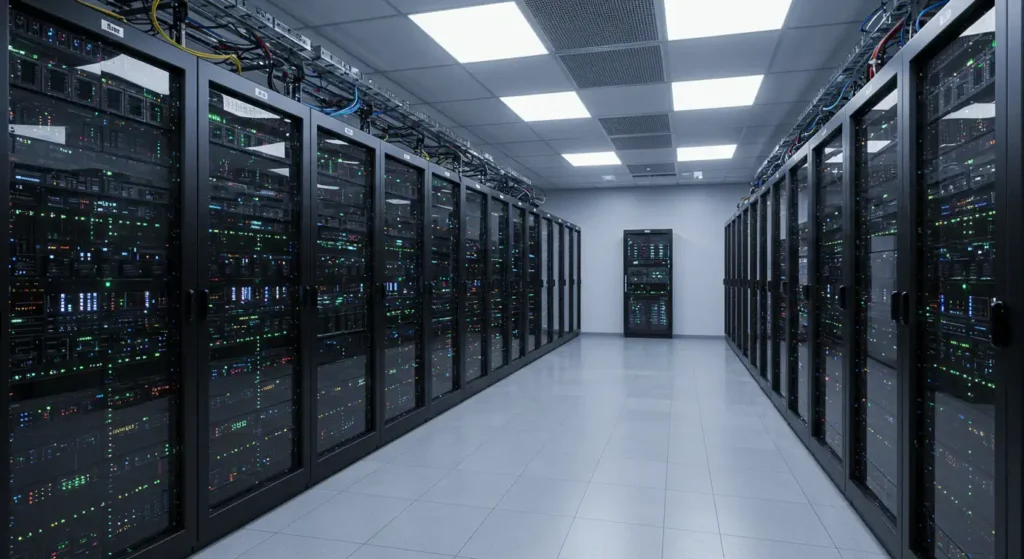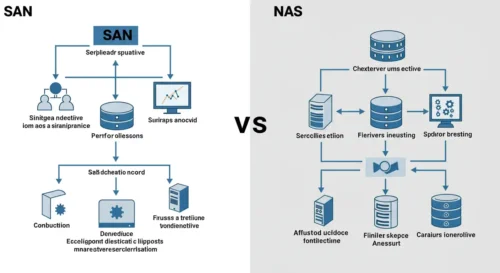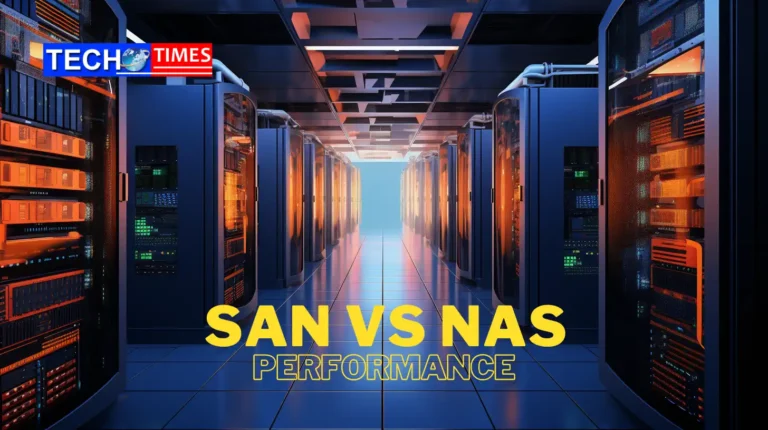Choosing the right storage solution is crucial for any organization. The performance of that solution directly impacts productivity, efficiency, and the ability to handle data-intensive workloads. When comparing SAN (Storage Area Network) and NAS (Network Attached Storage), several key factors come into play. Understanding these factors is essential for making an informed decision.
SAN vs NAS Performance : Unveiling the Dynamics of Storage Power
SAN and NAS are two distinct approaches to network storage, each with its own strengths and weaknesses. While both aim to provide accessible storage for networked devices, they differ significantly in their architecture, performance characteristics, and ideal use cases. This section will delve into the dynamics of their performance, exploring the underlying technologies and how they influence overall speed and efficiency.
I. Introduction: Understanding Storage Performance in SAN and NAS Environments
In today’s data-driven world, the need for efficient data storage solutions is more critical than ever. From small businesses to large enterprises, organizations require reliable and fast ways to store, process, and access their data. This makes the question of choosing the optimal data storage system a crucial one.
In this context, two primary types of storage systems that deserve attention are SAN (Storage Area Network) and NAS (Network Attached Storage). Both technologies offer unique characteristics and advantages, making them suitable for different tasks and needs.
SAN (Storage Area Network) is a specialized network that provides high-speed connectivity between servers and centralized storage. SAN typically utilizes technologies such as Fibre Channel or iSCSI for data transfer at the block level, ensuring maximum performance and minimal latency. This makes SAN an ideal solution for mission-critical applications such as databases, virtualization, and high-performance computing.
NAS (Network Attached Storage) is essentially a file server connected to an Ethernet network. NAS provides access to data at the file level, using protocols such as NFS or SMB/CIFS. NAS is easier to install and configure than SAN, and is typically used for file storage, data sharing, and backup.
Both SAN and NAS systems have their strengths and weaknesses. SAN delivers unparalleled performance and low latency but is more complex and expensive to deploy. NAS, on the other hand, is more affordable and easier to use but may have performance limitations for some workloads.
Thesis statement: SAN and NAS offer distinct performance characteristics, making them suitable for different applications and workloads. The choice between SAN and NAS depends on the specific needs of the business, performance requirements, budget, and other factors. Understanding the differences between these technologies is key to making an informed decision and choosing the optimal data storage solution.
Now, let’s delve into the five key factors that significantly influence storage performance in SAN and NAS environments:
-
Latency: Latency refers to the delay between a request for data and the actual delivery of that data. SAN, with its block-level access and technologies like Fibre Channel, generally offers lower latency compared to NAS, which operates at the file level. Lower latency is crucial for applications requiring real-time data access, like transactional databases.
-
Bandwidth: Bandwidth represents the amount of data that can be transferred within a given time. SAN, especially when using high-speed interconnects, typically provides higher bandwidth, making it suitable for data-intensive applications like video editing or large database transfers. NAS, while improving with faster Ethernet connections, can be a bottleneck for very high bandwidth needs.
-
IOPS (Input/Output Operations Per Second): IOPS measures the number of read and write operations a storage system can handle per second. SAN’s block-level access and dedicated connections often result in higher IOPS, which is essential for applications with many random read/write operations, such as virtualized environments or online transaction processing (OLTP) systems.
-
Scalability: Scalability refers to the ability of a storage system to grow and adapt to increasing storage needs. Both SAN and NAS offer scalability, but they achieve it differently. SAN often scales by adding more storage arrays to the network, while NAS typically scales by adding more NAS devices or upgrading existing ones. The ease and cost of scaling can vary significantly.
-
Protocol Efficiency: The protocols used for data transfer play a crucial role in performance. SAN often uses more efficient protocols designed for block-level access, like Fibre Channel or iSCSI. NAS relies on file-level protocols like NFS or SMB/CIFS, which can introduce overhead. Understanding the overhead associated with each protocol is essential for optimizing performance.
By carefully considering these five key factors – latency, bandwidth, IOPS, scalability, and protocol efficiency – organizations can make informed decisions about whether SAN or NAS is the most appropriate storage solution for their specific needs. The next sections will explore these factors in greater detail, comparing SAN and NAS performance in various scenarios.
II. Understanding SAN Architecture and Performance

SAN (Storage Area Network) is a dedicated high-speed network that connects servers to storage devices. Unlike NAS, which operates at the file level, SAN operates at the block level, providing raw storage to servers as if it were directly attached. This architecture enables SAN to deliver exceptional performance and low latency, making it ideal for demanding applications.
Underlying Technologies of SAN
Two primary technologies underpin SAN architecture:
- Fibre Channel (FC): FC is a high-speed, low-latency technology specifically designed for storage networking. It utilizes a dedicated fiber optic or copper cabling to connect servers and storage devices, providing reliable and high-bandwidth data transfer. FC is known for its exceptional performance and is commonly used in enterprise-level SAN deployments.
- iSCSI (Internet Small Computer System Interface): iSCSI is a protocol that allows SCSI commands to be transmitted over a TCP/IP network. This enables SAN to be deployed over existing Ethernet infrastructure, making it a more cost-effective option compared to FC. iSCSI offers a good balance of performance and affordability, making it suitable for a wider range of applications.
Advantages of SAN: High Bandwidth and Low Latency
SAN’s block-level access and dedicated network infrastructure provide several key advantages:
- High Bandwidth: SAN offers exceptional bandwidth, allowing for rapid data transfer between servers and storage devices. This is crucial for applications that require handling large volumes of data, such as databases and high-performance computing.
- Low Latency: SAN’s architecture minimizes latency, the delay between a request for data and the actual delivery of that data. Low latency is essential for applications that require real-time data access, such as transaction processing and virtualization.
- Scalability: SAN can easily scale to accommodate growing storage needs. Adding more storage devices or servers to the SAN is a straightforward process, ensuring that the storage infrastructure can keep pace with business growth.
- Centralized Management: SAN provides a centralized platform for managing storage resources. This simplifies administration and ensures consistent storage policies across the organization.
Use Cases Where SAN Excels
SAN’s exceptional performance and low latency make it an ideal choice for various demanding applications:
- Databases: SAN is widely used for hosting databases due to its ability to handle high transaction volumes and provide low-latency access to data.
- Virtualization: SAN is a popular choice for virtualization environments, as it provides the performance and scalability needed to support multiple virtual machines.
- High-Performance Computing (HPC): SAN’s high bandwidth and low latency make it well-suited for HPC applications that require processing massive datasets.
- Video Editing and Streaming: SAN’s ability to handle large files and provide real-time data access makes it suitable for video editing and streaming workflows.
By understanding the architecture and advantages of SAN, organizations can make informed decisions about whether it is the right storage solution for their specific needs.
III. Exploring NAS Architecture and Performance

NAS (Network Attached Storage) is a self-contained storage device that connects directly to a network, typically an Ethernet network. Unlike SAN, which presents block-level storage to servers, NAS provides file-level access to data, making it easier to share files among multiple users and devices.
Architecture of NAS and its Reliance on Ethernet Networks
NAS devices typically consist of one or more hard drives housed in a dedicated enclosure with a built-in network interface. They run a lightweight operating system that manages file sharing and network connectivity. NAS devices connect to the network via Ethernet, using standard network protocols like TCP/IP. This allows any device on the network with appropriate credentials to access the files stored on the NAS.
Performance Characteristics of NAS for File Sharing and General-Purpose Storage
NAS offers several advantages for file sharing and general-purpose storage:
- Ease of Use: NAS devices are relatively easy to set up and configure. They typically come with user-friendly interfaces that allow administrators to manage storage, users, and permissions.
- Cost-Effectiveness: NAS solutions are generally more affordable than SAN solutions, making them suitable for small to medium-sized businesses and home users.
- Centralized Storage: NAS provides a central repository for storing files, making it easier to manage and back up data.
- File Sharing: NAS excels at file sharing, allowing multiple users and devices to access files simultaneously.
However, NAS also has some performance limitations:
- Network Dependence: NAS performance is heavily dependent on the network infrastructure. Network congestion or latency can impact the speed of file transfers.
- Protocol Overhead: NAS uses file-level protocols like NFS or SMB/CIFS, which introduce some overhead compared to the block-level access of SAN.
- Limited Scalability: While NAS can scale to some extent, it may not be as scalable as SAN for very large storage needs.
Limitations of NAS Compared to SAN for Demanding Applications
For demanding applications that require high performance and low latency, NAS may not be the ideal solution. SAN’s block-level access and dedicated network infrastructure make it better suited for applications like databases, virtualization, and high-performance computing. NAS, with its file-level access and reliance on Ethernet networks, may struggle to keep up with the performance demands of these applications.
In summary, NAS is a great solution for file sharing, general-purpose storage, and backup. It offers ease of use, cost-effectiveness, and centralized management. However, for demanding applications that require high performance and low latency, SAN remains the preferred choice.
IV. Comparative Analysis: SAN vs NAS Performance

SAN and NAS are both popular storage solutions, but they differ significantly in their architecture, performance characteristics, and use cases. Understanding these differences is crucial for choosing the right storage solution for your specific needs.
Side-by-Side Comparison of SAN and NAS Performance Metrics
| Feature | SAN | NAS |
|---|---|---|
| Architecture | Block-level access, dedicated network | File-level access, Ethernet network |
| Protocols | Fibre Channel, iSCSI | NFS, SMB/CIFS |
| Performance | High bandwidth, low latency | Dependent on network, higher latency |
| Scalability | Highly scalable | Scalable, but less so than SAN |
| Complexity | Complex setup and management | Easier setup and management |
| Cost | More expensive | Less expensive |
| Use Cases | Databases, virtualization, HPC | File sharing, backup, general storage |
Factors Influencing Performance in SAN and NAS Environments
Several factors can influence the performance of both SAN and NAS environments:
- Network Congestion: In NAS environments, network congestion can significantly impact performance, as file transfers rely on the available network bandwidth. In SAN environments, dedicated network infrastructure minimizes the impact of congestion.
- Storage Protocols: The choice of storage protocols can also affect performance. SAN protocols like Fibre Channel and iSCSI are designed for high performance, while NAS protocols like NFS and SMB/CIFS have some inherent overhead.
- Storage Controllers: The performance of storage controllers in both SAN and NAS devices can impact overall performance. High-performance controllers can handle more requests and data transfers, improving performance.
- Disk Drives: The type and number of disk drives used in the storage system can also affect performance. Solid-state drives (SSDs) offer much higher performance than traditional hard disk drives (HDDs).
- Workload: The type of workload can also influence performance. Applications with high I/O requirements, such as databases, benefit from the high performance of SAN, while file sharing and backup operations can be efficiently handled by NAS.
Choosing the Right Storage Solution
Choosing the right storage solution depends on several factors, including:
- Performance Requirements: If your applications require high bandwidth and low latency, SAN is the better choice. For file sharing and general storage, NAS is usually sufficient.
- Scalability Needs: If you anticipate significant growth in your storage needs, SAN offers greater scalability than NAS.
- Budget: NAS solutions are generally more affordable than SAN solutions.
- Technical Expertise: SAN requires specialized technical expertise to set up and manage, while NAS is easier to manage.
Here are some general recommendations:
- Choose SAN if: You need high performance and low latency for mission-critical applications, have a large budget, and have the necessary technical expertise.
- Choose NAS if: You need to share files among multiple users, have a limited budget, and require easy setup and management.
By carefully considering these factors, you can choose the storage solution that best meets your specific needs and performance requirements.
V. Conclusion
SAN (Storage Area Network) and NAS (Network Attached Storage) are two primary types of storage systems that differ in their architecture, performance, and purpose. SAN, with its block-level architecture and use of high-speed technologies like Fibre Channel and iSCSI, provides unparalleled performance and low latency. NAS, on the other hand, uses a file-level architecture and connects to an Ethernet network, making it more accessible and easier to use, but with some performance limitations.
Key performance differences between SAN and NAS:
- Data transfer speed: SAN provides significantly higher data transfer speeds due to the use of specialized technologies and block-level data access.
- Latency: Latency in SAN is minimal, making it ideal for mission-critical applications that require instant data access.
- Scalability: SAN has greater scalability compared to NAS, allowing for easy expansion of the storage system as business needs grow.
- Complexity and cost: SAN is more complex and expensive to deploy and maintain compared to NAS.
The choice between SAN and NAS depends on the specific needs of the business and performance requirements. It is important to remember that the correct choice of storage system is critical to ensuring optimal performance and efficiency of the information system.
Future outlook on the evolution of storage technologies and their impact on performance:
Modern storage technologies are constantly evolving, and in the future, we can expect the emergence of new solutions that will combine the benefits of SAN and NAS. One such direction is the development of NVMe over Fabrics (NVMe-oF), which allows the use of the NVMe protocol to access NVMe drives over the network, providing high performance and low latency.
In addition, the development of artificial intelligence and machine learning will also affect data storage technologies. It is expected that intelligent storage systems will be able to automatically optimize performance and efficiency, taking into account the needs of specific applications and workloads.
Overall, the future of data storage technologies promises to be interesting and dynamic. New solutions will emerge that will provide even greater performance, scalability, and efficiency in working with data.
FAQ
What are the key differences between SAN and NAS?
SAN (Storage Area Network) and NAS (Network Attached Storage) are distinct storage solutions with different architectures and functionalities. SAN is a dedicated high-speed network that connects servers to storage devices, providing block-level access to data. This makes SAN ideal for high-performance applications requiring low latency, such as databases and virtualization. NAS, on the other hand, is a file-level storage system that connects directly to an Ethernet network. NAS is easier to set up and manage than SAN, making it suitable for file sharing, backup, and general-purpose storage.
Which storage solution is better for high-performance applications?
For high-performance applications that demand low latency and high bandwidth, SAN is generally the preferred choice. SAN’s block-level access and dedicated network infrastructure minimize latency and maximize data throughput, making it well-suited for applications like databases, online transaction processing, and high-performance computing.
How can I optimize the performance of my SAN or NAS environment?
Optimizing the performance of your SAN or NAS environment involves several key considerations:
Network Optimization: Ensure your network infrastructure is robust and properly configured. For NAS, a high-bandwidth Ethernet network is crucial. For SAN, consider using technologies like Fibre Channel or iSCSI to maximize performance.
Storage Configuration: Properly configure your storage devices, including RAID levels, disk types (SSD vs HDD), and caching mechanisms.
Workload Management: Understand your application workloads and prioritize critical applications to ensure they receive the necessary resources.
Monitoring and Tuning: Regularly monitor the performance of your storage environment and make adjustments as needed to maintain optimal performance.
What are the cost considerations for SAN and NAS solutions?
Cost is an important factor when choosing between SAN and NAS. SAN solutions tend to be more expensive due to the specialized hardware and expertise required for deployment and management. NAS solutions are generally more cost-effective, especially for small to medium-sized businesses. However, the total cost of ownership should be considered, including hardware, software, maintenance, and support.



